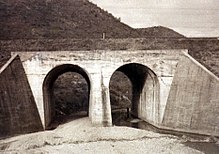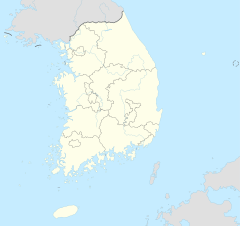| No Gun Ri massacre | |
|---|---|
| Part of the Korean War | |
 The twin-underpass railroad bridge at No Gun Ri, South Korea, in 1960. Ten years earlier, members of the U.S. military killed a large number of South Korean refugees under and around the bridge, early in the Korean War. | |
| Location | Nogeun-ri, South Korea (also known as No Gun Ri) |
| Coordinates | 36°12′55″N 127°52′49″E / 36.21528°N 127.88028°E |
| Date | July 26, 1950 – July 29, 1950 |
Attack type | Shooting and air attack |
| Deaths | At least 163 dead or missing, according to South Korea About 400 dead, according to survivors Unknown, according to the U.S. |
| Victims | South Korean refugees |
| Perpetrators | United States Armed Forces 7th Cavalry Regiment |
The No Gun Ri massacre (Korean: 노근리 양민 학살 사건) was a mass killing of South Korean refugees by U.S. military air and ground fire near the village of Nogeun-ri (노근리) in central South Korea between July 26 and 29, 1950, early in the Korean War. In 2005, a South Korean government inquest certified the names of 163 dead or missing and 55 wounded, and added that many other victims' names were not reported. The No Gun Ri Peace Foundation estimates 250–300 were killed, mostly women and children.
The incident was little-known outside Korea until publication of an Associated Press (AP) story in 1999 in which veterans of the U.S. Army unit involved, the 7th Cavalry Regiment, corroborated survivors' accounts. The AP also uncovered declassified U.S. Army orders to fire on approaching civilians because of reports of North Korean infiltration of refugee groups. In 2001, the United States Army conducted an investigation and, after previously rejecting survivors' claims, acknowledged the killings, but described the three-day event as "an unfortunate tragedy inherent to war and not a deliberate killing". Then-President Bill Clinton issued a statement of regret, adding the next day that "things happened which were wrong", but survivors’ demands for an apology and compensation were rejected.
South Korean investigators disagreed with the U.S. report, saying they believed that 7th Cavalry troops were ordered to fire on the refugees. The survivors' group called the U.S. report a "whitewash". The AP later discovered additional archival documents showing that U.S. commanders ordered troops to "shoot" and "fire on" civilians at the war front during this period; these declassified documents had been found but not disclosed by the Pentagon investigators. Among the undisclosed documents was a letter from the U.S. ambassador in South Korea stating that the U.S. military had adopted a theater-wide policy of firing on approaching refugee groups. Despite demands, the U.S. investigation was not reopened.
Prompted by the exposure of No Gun Ri, survivors of similar alleged incidents from 1950–51 filed reports with the Seoul government. In 2008, an investigative commission said more than 200 cases of alleged large-scale killings by the U.S. military had been registered, mostly air attacks.
